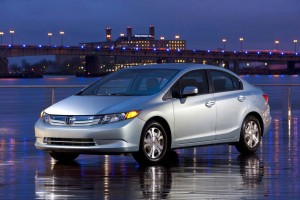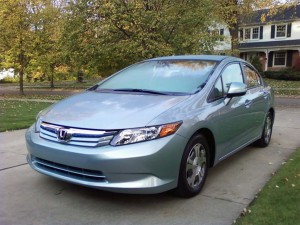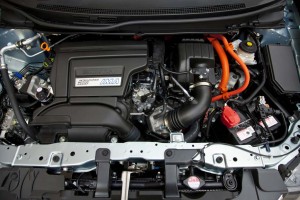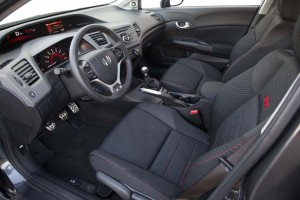You can barely read the auto section of your local newspaper, never mind the enthusiast magazines, without getting immersed in the new world of “electrification.” That is, of course, a fancy term for what most folks would call battery power. And regular readers of TheDetroitBureau.com know that I’ve been making it a point to look at some of the latest offerings to use batteries in their bid to go clean and green.
This time, however, I wanted to spend some time with a relatively conventional HEV model, rather than a pure “BEV” or “PHEV.” And, oh yeah, in case you’ve forgotten, a PHEV is a plug-in hybrid, a BEV is battery-only which means it has to be pluggable, and HEV is hybrid gas+electric power.
So, here is a closer look at my time behind the wheel of the latest-generation Honda Civic Hybrid. My fellow auto scribes have been beating up on Honda’s newest Civic because they perceive the interior trim doesn’t meet their collective mob standards. Well, most of them have a lot more opportunity than I do to eyeball all the competitors in the 2011/12 market place, so I can’t really challenge them on their views.
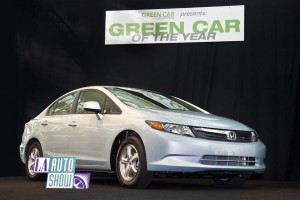
Significantly, it was the 2012 Honda Civic CNG model, and not the Hybrid that was named Green Car of the Year at the L.A. Auto Show.
My take on the latest Civic is based on a week with the Hybrid version, part of a series I’ve been pursuing on various EVs and the Urban Car concept. Write-ups in this space have included the $44,000 Volt PHEV, a $20,000 Fiat 500 (not EV but surely Urban), the $34,000 Leaf BEV and now the $27,000 Civic Hybrid HEV. I also briefly experienced a $20,000 Fiesta but not enough (because of illness) to review formally. All of these prices are “as tested” and do not take into account the shifting sands of discounts, lower equipment levels, transportation and government or employer subsidies.
To put the kicker up front, in this company the Civic HEV is a helluva deal at only seven grand over the a non-EV Civic LX. And that seven includes Navigation system, premium entertainment and other creature comforts besides freedom from the vagaries of gas pricing and availability. Honda actually list-prices the Civic Hybrid, devoid of the extras, for about $1,500 less than my test car.
(Honda reveals an array of new high-tech powertrains, including an electric version of its Super Handling-All-Wheel-Drive. Click Here for that story.)
Over a decade ago in 1999, Honda was the first to hit the US market with a hybrid gasoline-electric model, the Insight. It was a cute looking coupe that should have done well—except that, before 9/11/01, no one worried much about gasoline prices or availability, much less import of oil from the fractious Middle East or unstable Venezuela. Moreover, Global Warning/Climate Change/War on Fossil Fuels had not yet energized those of the environmental movement who actually drive cars (as opposed to “hate cars”).
So Honda Insight annual US sales, despite its visual and gas-sipping appeal, peaked at a measly 4,726 units in 2001, drifting downward to only 722 in 2006. In the meantime, Honda introduced a hybrid version of its popular compact Civic with first-year US sales of 13,707 and a peak in the decade of 32,575 in 2007. Visually, these first series Honda Civic Hybrids were virtually the same as the gas-engine-only models, and the same is pretty much true today. You have to look hard at the 2012 version beyond the modest trunk badging: it’s to be found only with a blue-colored upper horizontal bar on the front grille. (Or at least blue-colored on a car painted blue.)
Meanwhile, rival Toyota brought out its own Hybrid, labeled Prius, which also had a slow start until it became fashionable for the well- off First Responders and Greenies who wished to “make a statement.” Ford Motor Co. US followed in 2004 with hybrid versions of the Ford Escape and Mercury Mariner compact SUVs. Both Honda and Toyota had first tested the hybrid market in their homelands for a couple of years.
Initially, although doing better than the Honda Insight, Toyota Prius sales were exceeded by those of GM’s monster Hummers, when national gas prices averaged $1.50 per gallon. The hybrid’s time had not yet arrived. But by 2003 (just before launching a second-generation car with a distinctively unique appearance), Prius sales had climbed from 5,562 in 2000 (when they were only available from July on) to
24,000. By the Prius 10th anniversary last year of US introduction, an astounding 900,000 had been sold in America and total sales now have exceeded a million. Prius has been so successful compared to, say, Scion, that Toyota reportedly will make it a separate brand with spin-off hybids. Over the decade, Toyota and Lexus also introduced hybrid versions of their mid-sized sedans and SUVs.
Escape/Mariner/Fusion/Milan/MKZ hybrids have not fared so well compared to Toyota which early on, as noted, established itself as the “go to” for juice. Altogether, Ford has sold a bit over 180,000 hybrids, peak for Escape being 21,386 in 2007 and for Fusion, 20,816 in 2010. Ford’s total was hurt by the discontinuance of two offerings when the Mercury brand was killed off last year.
Why has Toyota been so successful compared to Honda? Opinions vary among auto scribes, but certainly Toyota’s mighty marketing machine is a big factor. Luck is also a factor, that which made the Prius and not the Civic a statement, a fad. You can’t say it was the appealing design of Prius; while beauty may be in the eye of the beholder, my opinion is that Prius is right there with Aztec when it comes to looks. But Prius has racked up superior fuel economy numbers, though the value of those in the pocket as opposed to reputation is questionable. (As mileage improves in the upper ranges, the savings are diminished: going from 20 mpg to 22 is a 10% gain; but from 40 to 42, only 5%.)
The purest of Greenies will flock to the Nissan Leaf, which is pure electric and never needs any of that despicable fossil fuel—except at the electrical generating plant. But pure electrics always will carry the worry of running out of juice because of unforeseen circumstances.
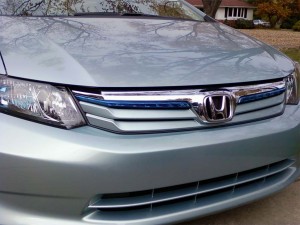
Would the Civic Hybrid do better in the marketplace with a more distinctive look, like Toyota's Prius?
So for now, in my opinion, the overall Urban Car choice today clearly comes down to hybrids, and among them, advantages in price, calculated mileage in the Government’s conversion formula wherein electrics are assigned a “miles per gallon” rate, and relative elegance. Price aside, the Volt would win. Considering price, Prius and Civic Hybrid are close enough in the mid-20s that the deal offered will likely be competitive.
There are sure to be a spate of forthcoming variations in technology over the coming years, so for those who care, cautious comparisons and study will be the order of the day.
In looking down the road during a recent EV conference, Ford Motor Company’s EV program is predicated not so much on Global Warming or even Fossil-Fuel Independence, but rather on the Urban Car Proposition. Ford foresees a 2020 global market demand among EVs of about 60-70 % HEVs, 20-30% PHEVs and 5-10% BEVs. The total EV share of Ford’s output a decade from now may range from 10 to 25%–that is very iffy and a big spread.
World population is climbing thanks to better health and, generally, the education and prosperity that accompanies globalization. And most of the new millions will inevitably flock to cities. So we will have more and more multi-million-population cities around the world.
And regardless of mass transit, many of those packed-tight-in-cities millions will demand the freedom of operating a car. This suggests impossible traffic jams, rationing of parking spaces and, naturally, mobile-source air pollution. Urban Cars and some form of more people-friendly power will be required, though this won’t happen overnight nor every place.
In the meantime, global auto companies will have lots of opportunity to experiment with new car-power and car-size concepts, and motorists can experiment with what fits their needs and purses—just as over the last 115 years.

